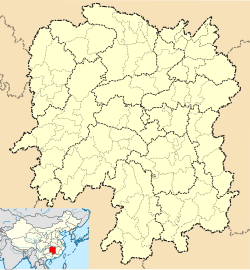Ruoshui, Huitong County
Ruoshui
若水镇 | |||||||
|---|---|---|---|---|---|---|---|
| Coordinates: 27°00′04″N 109°58′20″E / 27.00111°N 109.97222°E | |||||||
| Country | People's Republic of China | ||||||
| Province | Hunan | ||||||
| Prefecture-level city | Huaihua | ||||||
| County | Huitong County | ||||||
| Founded | 1103 | ||||||
| Incorporated (township) | 1956 | ||||||
| Designated (town) | 1995 | ||||||
| Area | |||||||
• Total | 200.52 km2 (77.42 sq mi) | ||||||
| Population (2019) | |||||||
• Total | 21,350 | ||||||
| • Density | 110/km2 (280/sq mi) | ||||||
| Time zone | UTC+08:00 (China Standard) | ||||||
| Postal code | 418312 | ||||||
| Area code | 0745 | ||||||
| Chinese name | |||||||
| Simplified Chinese | 若水镇 | ||||||
| Traditional Chinese | 若水鎮 | ||||||
| |||||||
Ruoshui (Chinese: 若水镇) is a town in Huitong County, Hunan, China.[1][2][3][4] As of the 2019 census it had a population of 21,350 and an area of 200.52-square-kilometre (77.42 sq mi).[1]
Administrative division
[edit]As of 2021, the town is divided into one community and twenty villages:
- Ruoshui Street Community (若水街社区)
- Ruoshui (若水村)
- Lilong (里龙村)
- Jichao (吉巢村)
- Wangdong (望东村)
- Basong (八宋村)
- Luchong (鲁冲村)
- Wayao (瓦窑村)
- Disifang (地四方村)
- Potang (坡塘村)
- Tanmu (檀木村)
- Changtian (长田村)
- Jiaping (架坪村)
- Wengshao (翁杓村)
- Wengdui (翁堆村)
- Wengding (翁顶村)
- Tangjian (塘枧村)
- Baopeng (抱蓬村)
- Huangmao (黄茅村)
- Tuanjie (团结村)
- Dongfeng (东风村)
History
[edit]In 1103, during the Northern Song dynasty (960–1127), it was known as Ruoshui Stockade Village (若水寨).[5]
From the Ming and Qing dynasties (1368–1911), the central government installed an agency of patrol and inspection known as Ruoshui Xunjiansi (若水巡检司) to administer the territory.[6]
After the founding of the Communist State, in November 1949, it belonged to the 1st District of Huitong County.[6] It was renamed Ruoshui District (若水区) in May 1955 and was changed to Ruoshui Township in June 1956.[6] In October 1958, it was renamed Ruoshui People's Commune (若水人民公社) and reverted to its former name of Ruoshui Township in May 1984.[6] In October 1995 it was upgraded to a town.[6] In 2015, Huangmao Township (黄茅乡) merged into the town.[7]
Geography
[edit]The town is located on the northeast of Huitong County.[1] The town shares a border with Jinzhu Town to the west, Gaoyi Township to the east, and Tuanhe Town to the south.[1]
The Wu River (巫水) flows through the town east to north.[1]
Economy
[edit]The local economy is primarily based upon agriculture and local industry.[5] The region abounds with coal, iron, lead, and zinc.[1]
Demographics
[edit]As of 2019, the National Bureau of Statistics of China estimates the town's population now to be 21,350.
| Year | Pop. | ±% |
|---|---|---|
| 2005 | 14,067 | — |
| 2011 | 13,900 | −1.2% |
| 2018 | 21,303 | +53.3% |
| 2019 | 21,350 | +0.2% |
| Source: [8] | ||
Transportation
[edit]The town has two provincial highways: the Provincial Highway S222 and Provincial Highway 318.[1]
References
[edit]- ^ a b c d e f g Li Liguo, Yu Changming & Duan Linyi 2015, pp. 2829–2830.
- ^ Wu, Xianqing 2012, p. 266.
- ^ Fu Junhua (付俊华); Tang Xinyi (唐心怡) (30 August 2023). 若水镇“最美退役军人”田云:打造群众满意的“乡村安居画卷”. htnews.cn (in Chinese). Retrieved 27 February 2024.
- ^ Tan Hui (谭辉) (13 December 2018). 怀化113个村落拟入选“第五批中国传统村落名录”,快看有你家乡吗. hn.rednet.cn (in Chinese). Retrieved 27 February 2024.
- ^ a b Wu, Xianqing 2012, p. 267.
- ^ a b c d e Wu, Xianqing 2012, pp. 20–21.
- ^ 怀化撤并93 个乡镇 你家乡变了没. Sohu (in Chinese). 3 December 2015. Retrieved 25 March 2024.
- ^ National Bureau of Statistics of China, ed. (2021). 中国县域统计年鉴·2020 [China County Statistical Yearbook in 2020] (in Chinese). Beijing: China Statistical Publishing House. p. 379. ISBN 9787503794735.
Bibliography
[edit]- Li Liguo; Yu Changming; Duan Linyi, eds. (2015). 中华人民共和国政区大典湖南省卷 [Volume of Hunan of the Encyclopedia of the People's Republic of China] (in Chinese). Beijing: China Social Publishing House. ISBN 9787508748160.
- Wu, Xianqing, ed. (2012). 会同县概况 [General Situation of Huitong County] (in Chinese). Beijing: Nationalities Publishing House. ISBN 978-7-105-12473-2.
